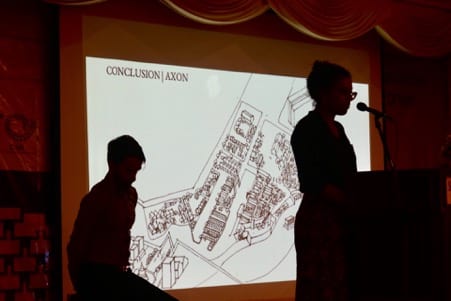The role of architectural knowledge vis-a-vis urban challenges. Nurturing the dialogue between educators and future practitioners
By Giovanna Astolfo, on 21 February 2018
With more than forty-five participants, the workshop and training “People-centred design” held at Yangon Technological University (YTU) between 13th-15th February brought together students, community architects and academics from Yangon, Mandalay, Bangkok and London, consolidating strategic partnerships and adding new layers of engagement between DPU, YTU, Silpakorn University and the Asian Coalition Housing Rights – Community Architects Network. Stemming from a series of discussions emerged last year around the nature and the possibility of an equal partnership, the aim of the three-day multi-target initiative was to support YTU in building the capacity of young professionals and staff to understand and engage with current urban challenges, in particular low income communities’ housing problems, while sharing theoretical and methodological insights in light of the three-year engagement with the MSc Building and Urban Design in Development at DPU.

People-centred design workshop – final group picture
The initiative aimed at fostering the reflexivity of students and staff towards the identification of knowledge needs and pedagogical challenges. The workshop exposed the participants to low income communities, their technologies, practices and agency. While experiencing the city – the ‘informal’ self-built city – students were tasked to observe and document material and immaterial aspects; as well as reflect upon their positionality. Learning how to critically observe, listen, reflect and narrate ultimately led to re-questioning the role of the practitioner/architect, its attitudes and skills. The training helped participants to reflect on how the new urban question is calling upon the recalibration of the architectural practice, and how this reflects in architectural education in terms of skills/knowledge/attitudes across different pedagogies. Urban challenges such as rapid informal urbanisation and the reproduction of spatial injustice have to be investigated and tackled by embracing a new and radical mode of practice. If challenges are utterly complex, is the old-fashion market-driven technical-based knowledge sufficient? Architecture and urban design should be seen as a series of processes that engage with political and social realities. What type of spatio-political knowledge is required within a studio then? The failure of modern architecture and urbanism in addressing people’s needs has shown the limits of thinking the built environment as an authoritative and autonomous discipline. Anyone can build. Anyone can be an architect. Whose creativity counts then? This calls upon re-questioning the role of the expert and the way in which discourses of expertise are constituted in particular contexts.

People-centred design workshop – brainstorming
Initially involved in separate activities, staff and students ended up together in a conclusive participatory reflection on the role of the of the knowledge in architectural and urban design practice. While discussing about skills, attitudes and knowledges, one of the participants asked “What are the right shoes for an architect?” looking down at the poster on the floor, representing a human body, possibly that of an architect and its embodied knowledges. Watson, Odendaal, Duminy et a., in their 2014 “The Planner in Dirty Shoes” would have argued that the right type of shoes entirely depends on “the unique ability (…) to take context into account and to get close to reality”. Indeed, architectural knowledge is situated, as it emerges from particular contexts of application, with and within their own theoretical frameworks, methods of research and practice. And architectural knowledge is relational, as knowledge production and learning are necessarily defined within relative positions, in conversation with existing discourses, material processes and the socially constructed and mediated structures of power. It is through unpacking these relational dimensions that we make sense of urban objects and processes, and identify opportunities for positive transformation. Finally, architectural knowledge is reflexive, especially with regard to the role and position of architects working within people-centred processes. It calls for a constant reflection upon and reinvention of the self and the other. Situated, relational and reflexive, three pedagogical challenges that foster a constitutive role for architectural knowledge in addressing spatial injustice.

People-centred design workshop – Supitcha Tovivich lecturing on What creativity counts
Far from being a narcissistic reflection on the disciplinary and professional role, the three-day activity enabled the encounter between pedagogical needs – shaped by new urban challenges, competences and methods. Delving into what it takes to make an architect, the training proved that education can be changed in a participatory way – meeting the needs of the students, a demand-led approach to curriculum change.

The “People-centred design” workshop and training is a three-day activity held in Yangon between 13-15th February 2018 at Yangon Technological University (YTU). The initiative is funded by UCL’s Global Engagement Funds and DPU’s TAS funds; organised and coordinated by DPU (Giovanna Astolfo and Camillo Boano) in collaboration with YTU and Association of Myanmar Architects – AMA (Ma Wah Wah); facilitated by Community Architects Network – CAN (Witee Wisuthumporn) along with Bithukar Community Platform (CBP) and DPU/ACHR/CAN interns (Saptarshi Mitra and Shoko Sakuma); with the participation and inputs from international guest lecturers Supitcha Tovivich (Silpakorn University, Bangkok), Catalina Ortiz (DPU) and Ma Pwint (YTU).
 Close
Close























